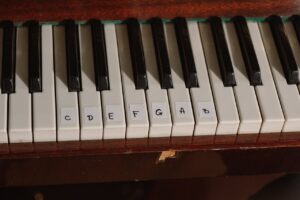Chords are the foundation of most music, shaping emotions, providing structure and adding color to a piece. Their impact, however, is heavily influenced by context as well as how they relate to the chords that come before and after. This relationship is known as a chord progression and it will be the focus of this article.
By the end of this article, you will gain a deeper understanding of chord progressions and discover helpful tips for playing, reading and learning them on piano. We will also explore some common chord patterns to help you improve your repertoire and musical skills. Without further delay, let’s jump right in and start exploring the world of chord progressions!
- Fall in love with the music - Learn your favorite songs, at a level suitable for you.
- Enjoy interactive piano lessons - Explore courses covering music theory, technique chords & more.
- Get real-time feedback - Skoove's feedback tells you what went well and what needs practice.

What are chord progressions?
Before we start, let’s recall that a chord is simply a collection of pitches that when played simultaneously, act as a harmonic unit. For instance, the pitches C, E, and G, form together the C major chord. If you’re feeling rusty on piano chords, however, feel free to read this article first, and then come back for more.
We can define a chord progression (also called harmonic progression) as a sequence of chords, ordered one after another. Notice that order is important here since the effect that a chord can have depends largely on what happens before and after it appears. Consider, for instance, the following chord progression
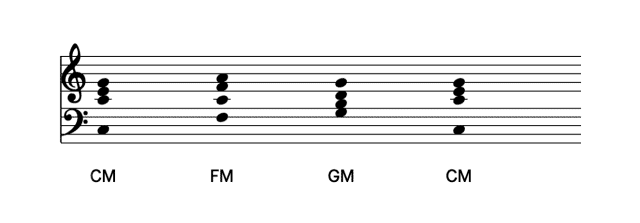
Here we have a progression consisting of 4 chords, C major,F major,G major and C major again. There’s a few things worth mentioning here:
- A chord progression can have chord repetitions or no repetitions at all
- Chord progressions are often in a specific key.
- The number of chords in a chord progression can vary greatly, but are usually between 4 and 8 chords long.
- Chord progressions often have a clear sense of direction (hence the word progression). More precisely, we can think of progressions as an interaction between moments of release and tension. Play this progression and pay attention to the amount of tension and release that each chord brings!
Common chord progressions
Now it’s time to look at some of the most common chord progressions, which you can incorporate into your daily piano practice.
| Progression | Number System | Chords in C Major |
|---|---|---|
| Pop Progression | I-V-vi-IV | C-G-Am-F |
| Pop Progression (Altered) | vi-IV-I-V | Am-F-C-G |
| Jazz Progression | ii7-V7-Imaj7 | Dm7-G7-Cmaj7 |
| 12 Bar Blues | I-I-I-I-IV-IV-I-I-V-IV-I-I or V | C-C-C-C-F-F-C-C-G-F-C-C or G |
| 50s (Doo-Wop) Progression | I-vi-IV-V | C-Am-F-G |
| Andalusian Cadence | Minor: i-VII-VI-V Major: i-bVII-bVI-V | Minor: Am-G-F-E Major: Cm-Bb-Ab-G |
| Modal Progression | I-bVII-IV | C-Bb-F |
| Root Movement Hotline | I-IV-viio-iii-vi-ii-V-I | C-F-Bdim-Em-Am-Dm-G-C |
| Pachelbel Progression | I–V–vi–iii–IV–I–IV–V | C-G-Am-Em-F-C-F-G |
| Royal Roads Progression | IV-V-iii-vi | F-G-Em-Am |
Popular chord progressions
Some are more popular than others, not only do they come up more often in music but can sometimes be strongly associated with specific popular music styles or genres. Let’s take a look at some of them.
The jazz progression
Chord progression: ii-V-I and ii7-V7-I7
Although this progression is extensively used in many kinds of music, it’s most commonly associated with jazz harmony. Try playing it these two version and see if it reminds you of any song:


Songs that use the ii7-V7-I7 progression include:
The 12-bar blues
Chord progression: I-I-I-I-IV-IV-I-I-V-IV-I-I or V
The 12-bar blues is another, perhaps even more, recognizable progression. This progression was particularly popular during the 50’s, but still crops up in all styles of music. Some of the many well known songs that use this pattern are: Rock and Roll Music by The Beatles, Still Haven’t Found What I’m Looking For by U2, and Hound Dog by Elvis Presley. Feel free to play it yourself:

The Pop progression
Chord progression: I–V–vi–IV
This progression is also featured in plenty of songs, including pop music hits like Taylor Swift’s Clean or Aerosmith’s Cryin’. Give it a try and see if it brings any other pop songs to mind.
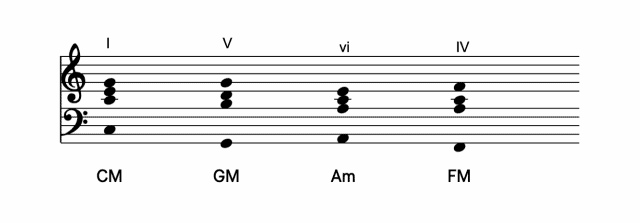
The Doo-Wop progression
Chord progression: I–vi–IV–V
Also known as the 50s progression, this chord progression is used by Elton John in Crocodile Rock, as well as by Avril Lavigne in Complicated. Try it yourself!
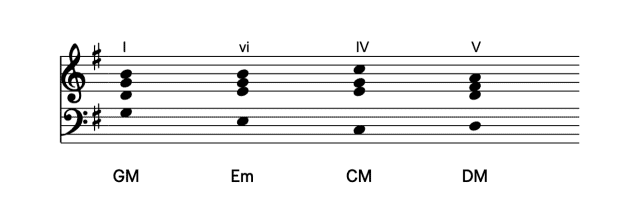
This progression is everywhere in music, from 1950’s doo-wop styles to contemporary pop and rock tunes. It also happens to be used in Eric Idle’s Always Look on the Bright Side of Life, which you can learn through the Skoove app.
The modal progression
Chord progression: I–bVII–IV–I
This progression is most common to find in Classic Rock. Different from the previous progressions, this one has what we call a ‘borrowed’ chord. This simply means that, even though it’s a major key progression, we find the bVII chord, which is being ‘borrowed’ from the minor key.
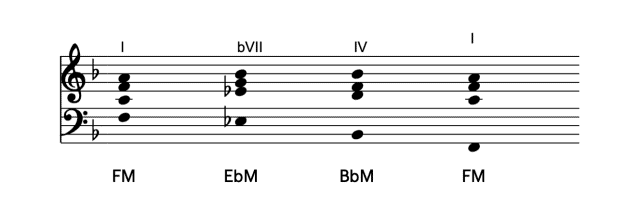
Popular examples of this include the final section of Hey Jude by The Beatles, or the verse in Guns N’ Roses’ Sweet Child O’ Mine.
The Pachelbel’s progression
Chord progression: I – V – vi – iii – IV – I – IV – V
Although this progression is sometimes associated with Johann Pachelbel’s Canon in D. Some relatively recent examples include Maroon 5’s song Memories, Belle and Sebastian Get me away from here I’m dying.

Mixing chords to create mood
A chord progression can create a narrative. The order and context and structure of each chord and chord progression can drastically change or subtly alter the atmosphere of the progressions you create. Have a go at these progressions and once you’re confident switch the chords, swap them about and see what your changes do to the feeling of each progression:
- “Happy” progression: I-IV-V
- “Sad” progression: vi-iii-V-IV
- “Hopeful” progression: IV-V-vi-I
Piano chords generator
This piano chords generator helps you to find any chord you need and will come in handy if you forget any chords along your way!
💡If you are reading this from a mobile device, rotate it to display the tool in full width.
- Click on “Chords”
- Choose the “Root” of the chord
- Choose the “Chord qualities” (major, minor, etc.)
- Click “Display”
How do chord progressions work?
Progressions are often described as an interplay between tension and release. In the previous example, C major provides release, G major creates tension and F major acts as a transition or contrast between the two.
How do progressions work? While an in-depth explanation is beyond this article, here are key concepts:

All available triads in C major
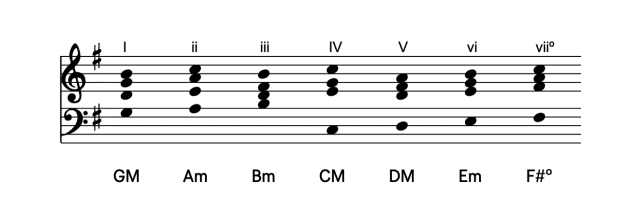
All available triads in G major
Consider all available triads in C major and G major. While chord names differ, their Roman numeral labels (I, ii, iii, etc.) remain the same. These labels help us understand chord relationships, regardless of the key.
- Major chords use uppercase numerals, minor chords lowercase (e.g., D minor in C major is ii).
- Diminished chords use lowercase numerals with a circle (e.g., viiº in G major).
• Flats or sharps (e.g., bVI or #VI) indicate a chord lowered or raised by a half-step.

All available triads in A harmonic minor piano scale
In most Western tonal music, chords serve three roles:
- Tonic: Provides closure or release, typically at the beginning or end of progressions.
- Dominant: Creates tension, often the climax of a phrase.
- Pre-dominant: Transitions between tonic and dominant.
To keep things less abstract, here’s a cheat sheet for both major and minor keys:

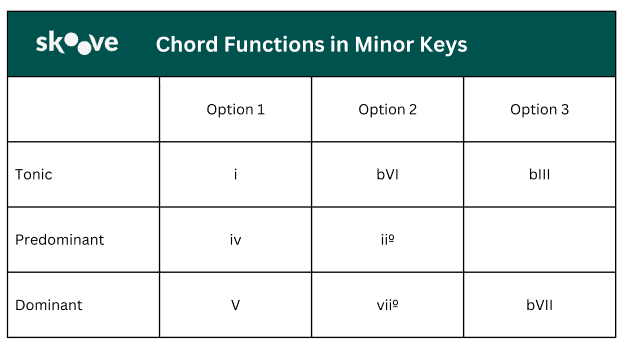
For each role, certain chords are preferred. For example, in a major key, I is a stronger tonic than vi or iii.
Now, if this still seems too abstract or complex, don’t worry! You’ll soon be able to use this to create your own chord progressions and eventually, your own songs!
Key takeaway on chord progressions
In this article, we explored different chord progressions, what they are, how they work as well as tips for writing, reading and playing them on the piano. While the topic can be challenging, mastering chord progressions is a highly rewarding skill.
The key is to practice regularly then incorporate your favorite progressions into your routine and as you grow more confident consider working through the Chords & Scales course. This will expand your musical knowledge and introduce you to more common progressions. Get creative, and soon you’ll be able to accompany hundreds of songs. Happy practicing!
Author of this blog post:

Published by Lydia Ogn from the Skoove team









